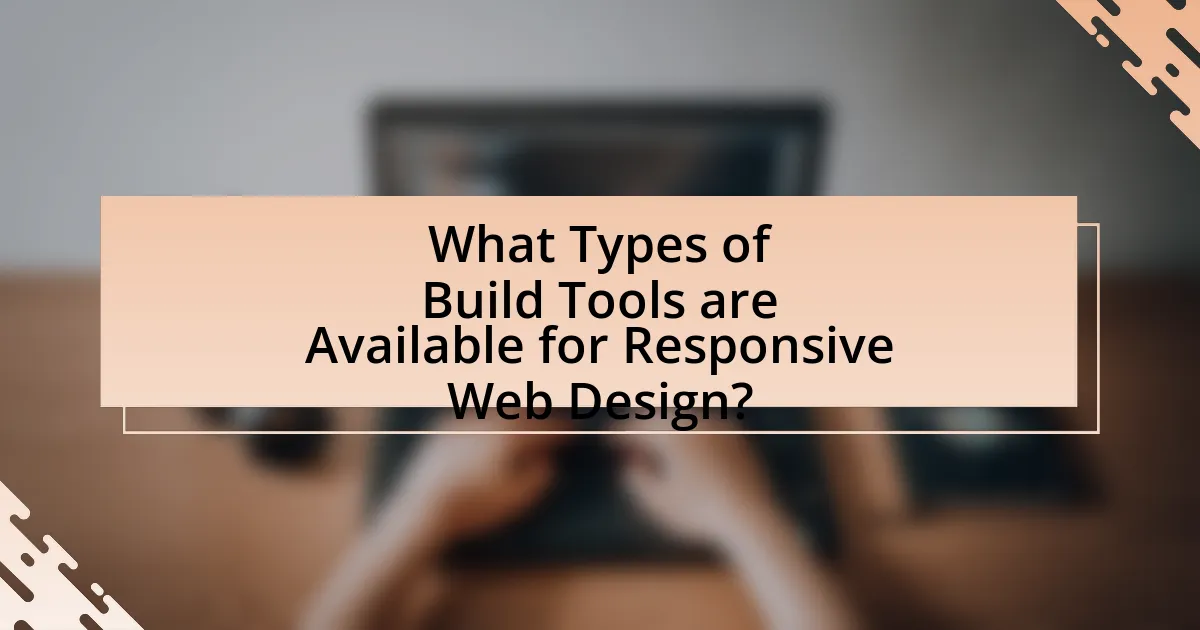Build tools are essential software applications that automate various tasks in web development, significantly enhancing the efficiency of responsive web design. This article explores the role of build tools such as Webpack, Gulp, and Grunt in streamlining workflows, optimizing assets, and managing dependencies to ensure websites adapt seamlessly to different devices. Key topics include the automation of tasks like file minification and image optimization, the importance of responsive design in today’s digital landscape, and best practices for leveraging these tools effectively. Additionally, the article discusses how CSS preprocessors enhance the capabilities of build tools, ultimately contributing to improved user experiences and collaboration among developers.
What are Build Tools and Their Role in Responsive Web Design?

Build tools are software applications that automate tasks in the web development process, such as compiling code, optimizing assets, and managing dependencies. In responsive web design, build tools play a crucial role by streamlining workflows, ensuring that websites adapt seamlessly to various screen sizes and devices. For instance, tools like Webpack and Gulp can automate the minification of CSS and JavaScript files, which enhances loading times and performance on mobile devices. Additionally, build tools facilitate the use of preprocessors like Sass or LESS, allowing developers to write more maintainable and scalable stylesheets that support responsive design principles.
How do Build Tools facilitate the development process?
Build tools facilitate the development process by automating tasks such as compilation, testing, and deployment, which enhances efficiency and reduces human error. For instance, tools like Maven and Gradle streamline project management by handling dependencies and building processes automatically, allowing developers to focus on writing code rather than managing configurations. Additionally, build tools support continuous integration and delivery (CI/CD) practices, enabling faster feedback loops and more reliable releases. This automation is crucial in modern development environments, where speed and accuracy are paramount for successful project outcomes.
What specific tasks do Build Tools automate in web design?
Build tools automate tasks such as file minification, compilation of pre-processors (like Sass or LESS), image optimization, and code linting in web design. These tools streamline the development process by reducing the need for manual intervention in repetitive tasks, thus enhancing efficiency and consistency. For instance, minification reduces file sizes, improving load times, while image optimization ensures that images are appropriately sized for web use, contributing to better performance. Additionally, code linting helps maintain code quality by identifying errors and enforcing coding standards automatically.
How do Build Tools improve collaboration among developers?
Build tools improve collaboration among developers by automating the build process, ensuring consistency, and facilitating integration. These tools streamline tasks such as compiling code, running tests, and packaging applications, which reduces the likelihood of errors and discrepancies between different development environments. For instance, tools like Maven and Gradle allow teams to define project dependencies and build configurations in a standardized manner, enabling all developers to work with the same setup. This uniformity fosters better communication and understanding among team members, as everyone operates under the same guidelines and expectations. Additionally, build tools often include features for continuous integration, which allows developers to merge their changes frequently and receive immediate feedback, further enhancing collaborative efforts.
Why is Responsive Web Design important in today’s digital landscape?
Responsive Web Design is important in today’s digital landscape because it ensures optimal user experience across a variety of devices and screen sizes. With over 50% of global web traffic coming from mobile devices, responsive design allows websites to adapt seamlessly, improving accessibility and engagement. Additionally, Google prioritizes mobile-friendly websites in search rankings, making responsive design crucial for visibility and SEO. This adaptability not only enhances user satisfaction but also drives higher conversion rates, as users are more likely to stay on a site that functions well on their device.
What are the key principles of Responsive Web Design?
The key principles of Responsive Web Design are fluid grids, flexible images, and media queries. Fluid grids allow layout elements to resize proportionally, ensuring that the design adapts to various screen sizes. Flexible images are scaled to fit within their containing elements, preventing overflow and maintaining visual integrity across devices. Media queries enable the application of different styles based on device characteristics, such as screen width, allowing for tailored user experiences. These principles collectively ensure that websites provide optimal viewing and interaction experiences across a wide range of devices and screen sizes.
How does Responsive Web Design enhance user experience?
Responsive Web Design enhances user experience by ensuring that websites adapt seamlessly to various screen sizes and devices. This adaptability leads to improved accessibility, as users can easily navigate and interact with content regardless of whether they are using a smartphone, tablet, or desktop. According to a study by Google, 61% of users are unlikely to return to a mobile site they had trouble accessing, highlighting the importance of a responsive design in retaining users. Furthermore, responsive design contributes to faster loading times and reduced bounce rates, as optimized layouts and images enhance performance across devices.
What Types of Build Tools are Available for Responsive Web Design?

There are several types of build tools available for responsive web design, including task runners, module bundlers, and CSS preprocessors. Task runners like Gulp and Grunt automate repetitive tasks such as minification, compilation, and image optimization, enhancing workflow efficiency. Module bundlers like Webpack and Parcel manage and bundle JavaScript files, allowing developers to work with modular code while optimizing load times. CSS preprocessors such as Sass and LESS extend CSS capabilities with features like variables and nesting, facilitating more organized and maintainable stylesheets. These tools collectively streamline the development process and improve the performance of responsive web applications.
What are the most popular Build Tools used in web development?
The most popular build tools used in web development include Webpack, Gulp, Grunt, and Parcel. Webpack is widely recognized for its module bundling capabilities, allowing developers to manage dependencies efficiently. Gulp is favored for its streaming build system, which enables faster task execution through code over configuration. Grunt, an earlier tool, is known for its extensive plugin ecosystem that automates repetitive tasks. Parcel stands out for its zero-configuration setup, making it user-friendly for beginners. These tools are essential for optimizing workflows and enhancing the development process in responsive web design.
How do task runners like Gulp and Grunt contribute to web design?
Task runners like Gulp and Grunt streamline web design processes by automating repetitive tasks such as file minification, image optimization, and code compilation. This automation enhances efficiency, allowing designers and developers to focus on creative aspects rather than manual tasks. For instance, Gulp uses a code-over-configuration approach, enabling faster builds through its streaming capabilities, while Grunt relies on a configuration-based setup that organizes tasks in a clear manner. Both tools contribute to a more efficient workflow, reducing the time spent on mundane tasks and improving overall productivity in web design projects.
What role do module bundlers like Webpack play in responsive design?
Module bundlers like Webpack play a crucial role in responsive design by optimizing and managing the assets required for different screen sizes and devices. They enable developers to bundle JavaScript, CSS, and images, ensuring that only the necessary files are loaded for a specific viewport, which enhances performance and user experience. For instance, Webpack’s code-splitting feature allows for loading only the essential code for the initial render, reducing load times on mobile devices. This targeted asset management is essential for creating responsive web applications that perform efficiently across various platforms.
How do CSS preprocessors enhance the capabilities of Build Tools?
CSS preprocessors enhance the capabilities of Build Tools by introducing advanced features such as variables, nesting, and mixins, which streamline the styling process and improve code maintainability. These features allow developers to write more efficient and organized CSS, reducing redundancy and enhancing readability. For instance, using variables enables consistent theming across stylesheets, while nesting allows for a clearer hierarchy in styles, making it easier to manage complex layouts. Additionally, preprocessors like Sass and LESS integrate seamlessly with Build Tools, enabling automated compilation and optimization of CSS files, which improves performance and reduces load times. This integration supports responsive design by allowing developers to create media queries and responsive styles more intuitively, ultimately leading to a more efficient workflow and better user experiences.
What advantages do preprocessors like SASS and LESS offer?
Preprocessors like SASS and LESS offer significant advantages in CSS development, including enhanced functionality through variables, nesting, and mixins. These features allow developers to write more maintainable and reusable code, reducing redundancy and improving organization. For instance, SASS enables the use of variables to store colors and font sizes, which can be reused throughout the stylesheet, ensuring consistency and simplifying updates. Additionally, nesting allows for a clearer hierarchy in styles, making it easier to read and manage complex CSS structures. Furthermore, mixins facilitate the inclusion of reusable styles, which can streamline the coding process and enhance efficiency. Overall, these capabilities contribute to a more efficient workflow and better maintainability in responsive web design.
How can preprocessors streamline the styling process for responsive designs?
Preprocessors streamline the styling process for responsive designs by enabling the use of variables, nesting, and mixins, which enhance code organization and maintainability. For instance, variables allow designers to define color schemes and breakpoints once, promoting consistency across stylesheets. Nesting facilitates a hierarchical structure that mirrors HTML, making it easier to manage styles for different screen sizes. Mixins enable the reuse of style rules, reducing redundancy and simplifying updates. These features collectively lead to more efficient coding practices, ultimately resulting in faster development cycles and easier adjustments for responsive layouts.
How to Effectively Leverage Build Tools for Responsive Web Design?

To effectively leverage build tools for responsive web design, utilize tools like Webpack, Gulp, or Grunt to automate tasks such as minification, image optimization, and CSS preprocessing. These tools streamline the development process by allowing developers to focus on writing code while the build tools handle repetitive tasks, ensuring that the final product is optimized for various screen sizes. For instance, using Gulp can significantly reduce load times by automating image compression, which is crucial for mobile users. Additionally, integrating responsive frameworks like Bootstrap or Foundation within these build tools can enhance the design’s adaptability across devices, as they provide pre-built components that are inherently responsive.
What best practices should be followed when using Build Tools?
When using build tools, it is essential to follow best practices such as maintaining a consistent directory structure, automating repetitive tasks, and utilizing version control. A consistent directory structure enhances organization and makes it easier for team members to navigate the project. Automating tasks like minification, compilation, and testing reduces human error and saves time, leading to more efficient workflows. Utilizing version control, such as Git, ensures that changes are tracked, facilitating collaboration and rollback capabilities if needed. These practices contribute to a more streamlined development process and improve overall project quality.
How can developers optimize their workflow with Build Tools?
Developers can optimize their workflow with Build Tools by automating repetitive tasks such as compiling code, minifying files, and managing dependencies. This automation reduces manual errors and saves time, allowing developers to focus on writing code rather than performing routine tasks. For instance, tools like Webpack and Gulp streamline the build process by enabling hot module replacement and task automation, which enhances development speed and efficiency. According to a survey by Stack Overflow, 70% of developers reported that using build tools significantly improved their productivity, demonstrating the effectiveness of these tools in optimizing workflows.
What common pitfalls should be avoided when implementing Build Tools?
Common pitfalls to avoid when implementing Build Tools include neglecting proper configuration, failing to keep dependencies updated, and overlooking performance optimization. Proper configuration is crucial because misconfigured build tools can lead to inconsistent builds and deployment issues. Keeping dependencies updated is essential to avoid security vulnerabilities and compatibility problems, as outdated libraries can introduce bugs. Performance optimization should not be ignored, as inefficient build processes can slow down development cycles and increase deployment times. These pitfalls can significantly hinder the effectiveness of Build Tools in achieving responsive web design.
What are some practical tips for troubleshooting Build Tools in web design?
To troubleshoot Build Tools in web design effectively, start by checking the configuration files for errors, as misconfigurations are a common source of issues. Ensure that all dependencies are correctly installed and up to date, since outdated or missing packages can lead to build failures. Utilize the command line to run build commands with verbose logging, which provides detailed output that can help identify where the process is breaking down. Additionally, clear the cache of the build tool, as corrupted cache files can cause unexpected behavior. Finally, consult the documentation for the specific build tool being used, as it often contains troubleshooting sections that address common problems and their solutions.
How can developers identify and resolve common issues with Build Tools?
Developers can identify and resolve common issues with Build Tools by systematically analyzing error messages, reviewing configuration files, and utilizing community resources. Error messages often provide specific insights into what went wrong, allowing developers to pinpoint the issue quickly. Configuration files, such as build.gradle or pom.xml, should be checked for syntax errors or misconfigurations that could lead to build failures. Additionally, developers can leverage community forums, documentation, and version control history to find solutions to similar problems encountered by others. This approach is supported by the fact that many developers report resolving issues through community engagement and thorough documentation review, which enhances their understanding of the tools and their configurations.
What resources are available for learning more about Build Tools and responsive design?
Resources for learning about Build Tools and responsive design include online platforms like freeCodeCamp, which offers comprehensive courses on web development and responsive design principles. Additionally, Mozilla Developer Network (MDN) provides extensive documentation and tutorials on CSS and responsive design techniques. Books such as “Responsive Web Design with HTML5 and CSS” by Ben Frain offer in-depth knowledge on the subject. Furthermore, community forums like Stack Overflow and GitHub repositories can provide practical insights and examples from real-world projects. These resources collectively cover both theoretical and practical aspects of Build Tools and responsive design.